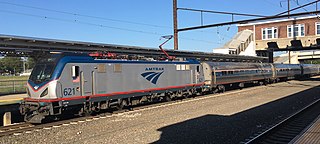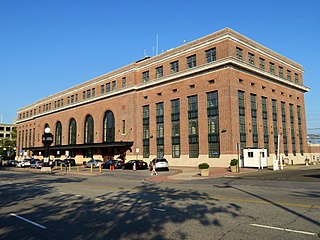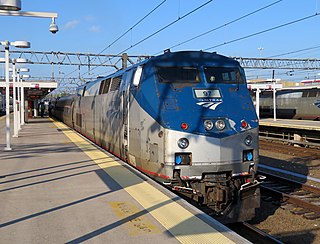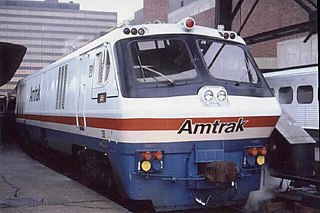
The Acela is Amtrak's flagship passenger train service along the Northeast Corridor (NEC) in the Northeastern United States between Washington, D.C., and Boston via 13 intermediate stops, including Baltimore, New York City and Philadelphia. Acela trains are the fastest in the Americas, reaching 150 miles per hour (240 km/h), but only over 49.9 miles (80.3 km) of the 457-mile (735 km) route.

The Northeast Corridor (NEC) is an electrified railroad line in the Northeast megalopolis of the United States. Owned primarily by Amtrak, it runs from Boston in the north to Washington, D.C., in the south with major stops in Providence, New Haven, Stamford, New York City, Trenton, Philadelphia, Wilmington, and Baltimore. The NEC closely parallels Interstate 95 for most of its length, and, as of 2013, is the busiest passenger rail line in the United States both by ridership and by service frequency. The NEC carries more than 2,200 trains daily.

The New York, New Haven and Hartford Railroad, commonly known as The Consolidated, or simply as the New Haven, was a railroad that operated principally in the New England region of the United States from 1872 to December 31, 1968. Founded by the merger of the New York and New Haven and Hartford and New Haven railroads, the company had near-total dominance of railroad traffic in Southern New England for the first half of the 20th century.

The Northeast Regional is an intercity rail service operated by Amtrak in the Northeastern and Mid-Atlantic United States. In the past it has been known as the NortheastDirect, Acela Regional, or Regional. It is Amtrak's busiest route, carrying 8,686,930 passengers in fiscal year (FY) 2018, a 1.4% increase over the 8.57 million passengers in FY 2017. The Northeast Regional service earned over $613.9 million in gross ticket revenue in FY 2016, a 0.4% increase over the $611.7 million earned during FY 2015.

The Empire Service is an Inter-city rail service operated by Amtrak within the state of New York in the United States. The brand name originated with the New York Central Railroad in 1967. Trains on the line provide frequent daily service along the 460-mile (740 km) Empire Corridor between New York City and Niagara Falls via Albany, the state capital.

The Metroliners were extra-fare high-speed trains between Washington, D.C., and New York City which operated from 1969 to 2006. They were briefly first operated by Penn Central Transportation, then by Amtrak for 35 years.

The Keystone Service is a 195 mile regional passenger train service from Amtrak between the Harrisburg Transportation Center in Harrisburg, Pennsylvania, and 30th Street Station in Philadelphia, running along the Philadelphia to Harrisburg Main Line. Most trains continue along the Northeast Corridor (NEC) to Penn Station in New York City.

Union Station, also known as New Haven Railroad Station or simply New Haven, is the main railroad passenger station in New Haven, Connecticut. It is the third such station in the city of New Haven, preceded by both an 1848 built station in a different location, and an 1879 built station near the current station's location. Designed by noted American architect Cass Gilbert, the present beaux-arts Union Station was completed and opened in 1920 after the previous Union Station was destroyed by fire. It served the New York, New Haven and Hartford Railroad for the next five decades, but fell into decline following World War II along with the United States railroad industry as a whole.
The Colonial, also known as the Colonial Express, was a service of the Pennsylvania Railroad and New York, New Haven and Hartford Railroad between Union Station in Washington, DC and South Station in Boston, Massachusetts. It was operated until 1973 by Amtrak.
The Federal Express was an overnight named passenger train run by the Pennsylvania Railroad and the New York, New Haven and Hartford Railroad between Washington, DC's Union Station and Boston, Massachusetts's South Station from 1912 to 1971. At different times, its route has taken it across the Hudson River via a car float between Port Morris and Jersey City, the Poughkeepsie Bridge, and finally the Pennsylvania Tunnel and Terminal Railroad. The final routing was identical to today's high-speed Northeast Corridor.

The New Haven–Springfield Line is a railroad line owned by Amtrak from New Haven, Connecticut, north to Springfield, Massachusetts, serving the Knowledge Corridor. As a branch of the Northeast Corridor just north of New Haven State Street station, it is served by approximately seven daily Northeast Regional round trips, some continuing from New Haven to Washington, D.C., along the Corridor and others terminating at New Haven as shuttles. On weekends, there is one train daily to Roanoke, Virginia. It is also served by the daily Vermonter, which starts in Washington, D.C., and continues north from Springfield, finally terminating in St. Albans, Vermont. The line is part of the Inland Route connecting Boston and New York via Hartford, Springfield, and Worcester, in contrast to the "Shore Line" along the Connecticut Shore and through Rhode Island.

The Cape Codder was a seasonal passenger train operated by Amtrak between New York City and Hyannis, Massachusetts, on Cape Cod. It operated during the summer between 1986 and 1996. It was the first regular service from New York to the Cape since 1964. The New York, New Haven and Hartford Railroad previously had operated a train under this name until 1958.

The Hartford Line is a train service run by Amtrak primarily between Springfield, Massachusetts, and New Haven, Connecticut, along Amtrak's New Haven–Springfield Line.

The Beacon Hill was a daily 157-mile (253 km) commuter rail service operated by Amtrak between Boston, Massachusetts, and New Haven, Connecticut, from 1978 to 1981. The Beacon Hill was one of the last long-haul commuter services operated by Amtrak. Service consisted of a single rush-hour round trip, with service eastbound to Boston in the morning and westbound to New Haven in the evening.
The Bankers was a passenger train operated by the New York, New Haven and Hartford Railroad between Grand Central Terminal, New York City and Springfield, Massachusetts. Under the New Haven the Bankers provided early morning express service from Springfield to New York, running non-stop from New Haven, Connecticut. The Bankers was paired with the Nathan Hale, which ran an hour later. In the afternoon the train returned as the Connecticut Yankee. The Bankers carried parlor cars, a grill (dining) car and coaches.
The Twilight Limited was a named passenger train in the United States which initially operated between Chicago, Illinois, and Detroit, Michigan. The New York Central Railroad introduced the train in 1926, and it continued until the formation of Amtrak in 1971, although it lost its name in 1967. Amtrak renamed the train St. Clair, feeling that the name "Twilight Limited" had undesirable connotations and imagery for a company trying to save passenger rail service. Amtrak revived the name in 1976 for a new train frequency on the Chicago–Detroit corridor, and kept the name until all trains on that corridor were renamed Wolverine in 2004.
The Clamdigger was a daily passenger train which ran along the Northeast Corridor during the 1970s. The train had two iterations: from 1898 to 1972 it was a local commuter service under the New Haven Railroad, Penn Central, and Amtrak between New London and New Haven, while from 1976 to 1978 it was a long-distance commuter service operated by Amtrak from Providence to New Haven. In 1978, it was canceled and replaced with the Beacon Hill.
The Night Owl was a passenger train operated by Amtrak on the Northeast Corridor between Washington, D.C., and Boston, Massachusetts, via New York City. It operated from 1972 to 1995 on an overnight schedule with sleeper service; it was the only such train on the Northeast Corridor. In 1995 Amtrak dropped most individual train names from its Northeast Corridor services and the Night Owl became another NortheastDirect service, but still on an overnight schedule. Amtrak replaced it with the Twilight Shoreliner in 1997.

The Connecticut Yankee was a long-distance train in western New England, that in its first two decades was an international night train, established in 1936, that extended from New York City into southeastern Quebec, to Sherbrooke and Quebec City, a 549-mile (884 km) trip. The pooled train covered railroad territories of the New York, New Haven and Hartford, Boston and Maine, Canadian Pacific Railway and the Quebec Central Railway. It was the last U.S.-Canadian train serving the Sherbrooke to eastern Vermont route.














